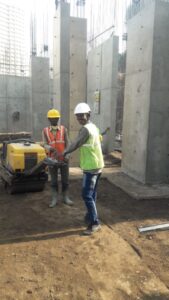Preparation
- Do not start backfilling until Site Engineer gives his approval to do so with sign off
- Ensure the concrete structures are sufficiently cured, Repaired all Quality defects and the waterproofing done as per approved methodology before initiating the backfilling works
- Ensure waterproofing is protected with Dimple board and Geotextile prior to Back fill
- It is recommended that In the case of backfilling along retaining walls; Slab over the retaining wall needs to be casted prior to start the backfilling activity otherwise instructed by EIC
- Recommend the concrete being cured or and concrete strength results are attained satisfactory results in 14 days (85% as per IS 456) prior to back fill.
- If to be commenced in advance, suggested to commence the back fill works post obtaining the approval from Zonal QAQC head with ACT cube test results and 3 days cube results.
- Note, the above requirements are listed, to avoid huge rework in case of concrete strength failure and the commencement of backfilling is fully zonal Quality head and Construction head discretion and that is final.
- Ensure that the top soil is preserved well as per IGBC requirement and not consumed for back fill as it recommend to use for garden purpose
- Remove all shuttering materials, steel bars etc., from area to be filled and clean the pit.
- Mark filling level on column /wall etc.,
- Provide anti-termite treatment before backfilling, if specified.
- Remove roots of trees coming in the portion of excavation pits and fill up hollows during backfilling.
- Material used for backfilling shall be any one or combination of soil types mentioned in material guidelines but not mixed together as MDD will vary.
- The Soil to be approved by site QAQC for back filling as per the below listed testing Guidelines.
- The levels and stability of the existing ground level should be checked.
- Earth rammer (Plate compactor) or ½ tonee roller or a vibratory roller should be available for compaction depending upon the type of soil (like cohesive, granular and well graded).
- If the depth of filling for 1.2mtrs vibratory roller recommend to be used to consolidate the filling unless otherwise instructed by EIC.

The soil compaction equipment’s can be divided into two groups:
1. Light soil compacting equipment’s
2. Heavy soil compacting equipment’s
1. Light Soil Compacting Equipment’s:
These equipment’s are used for soil compacting of small areas only and where the compacting effort needed is less.
Below are the light equipment’s for soil compaction:
Earth Rammers:
- For machine operated rammers, the usual weight varies from 30kg to 10 tons (6 lbs. to 22000 lbs.). These hammers with 2- 3 tons (4400 to 6600 lbs.) weights are allowed to free fall from a height of 1m to 2m (3ft to 7ft) on the soil for the compaction of rock fragments.
- Rammers are suitable for compacting cohesive soils as well as other soils.

Vibrating Plate Compactors:
- Vibrating plate compactors are used for compaction of coarse soils with 4 to 8% fines. These equipment’s are used for small areas.
- The usual weights of these machines vary from 100 kg to 2 tonne with plate areas between 0.16 m2 and 1.6 m2
2. Heavy Soil Compaction Equipment’s:
- These compacting machines are used for large areas for use on different types of soils.
- The heavy compaction equipment’s are selected based on moisture content of soil and types of soil.
Following are different types of these equipment’s:
Smooth Wheeled Rollers:
- The smooth wheeled rollers consist of one large steel drum in front and two steel drums on the rear. The gross weight of these rollers is in the range of 8-10 tons (18000 to22000 lbs.).
- The performance of these rollers can be increased by increasing the increasing the weight of the drum by ballasting the inside of drums with wet sand or water.
- About 8 passes are adequate for compacting 30 cm layer. A speed of 3-6 kmph is considered appropriate for smooth wheel rollers.
Smooth wheeled rollers are of two types:
1. Static smooth wheeled rollers
- The suitable soils for these roller type are well graded sand, gravel, crushed rock, asphalt etc. where crushing is required.
- These are used on soils which do not require great pressure for compaction.
- These rollers are used for finishing the upper surface of the soil. These roller are not used for compaction of uniform sands.
2. Vibrating smooth wheeled rollers
- These drums are made to vibrate by employing rotating or reciprocating mass. These
rollers are helpful from several considerations like:-
o Higher compaction level can be achieved with maximum work
o Compaction can be done up to more depths
o Output is more than conventional rollers - As rolling proceeds sprinkle water to assist consolidation.
- Soil after compaction shall be free from pockets underneath

Compaction Method
Layer Wise Method
- Carry out backfilling in layers of thickness not exceeding 300mm depending on compaction equipment or as per specifications.
- Make sure that the distribution of the soil is even so as to provide the ample lateral supports for the walls & columns of the structures.
- If moisture content of soil is high then rake the soil and allow moisture to evaporate
- The method of compaction will depend upon the soil type, the maximum dry density required and economic consideration.

Post Backfilling
- Ensure the compaction is checked using calibrated FDD equipment by site laboratory personnel and the Same being tested for understanding the compaction percentage i.e. 95% for building or 97% for Roads, Drains etc.,. by grid marking – one test per 100 sqm.
